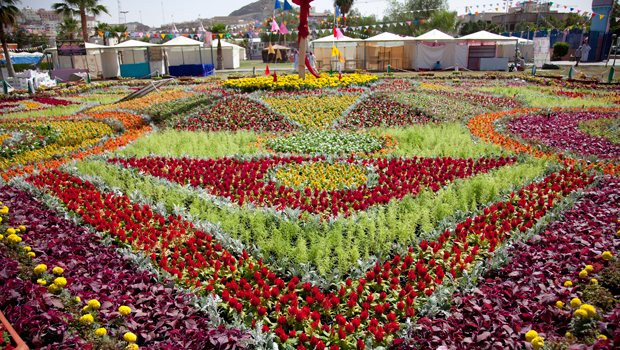Stretched along the roads and streets of Taif are many vendors displaying cork boxes full of fragrant homegrown roses, fruits and other fresh produce.
In addition, the city produces rose essence and rose water, and every year the municipality and the Saudi Commission for Tourism and Antiquities organizes a rose festival, which is visited by both local and international tourists.
Despite the difficult conditions, such as scarcity of water and laborers during the rose cultivation season, the number of rose plantations reached 750 during the last year festival. These are mostly located in the cooler Al-Hada, Al-Shafa, Al-Dahia, and Al-Ghadeerain areas. Together, they produce around 233 million roses and comprise 34 factories for the plantation of roses and production of 19,000 bottles of rose essence.
The planting of roses usually coincides with the end of the month of January and lasts up to 75 days. Planters start with digging groves in the plantation soil, in which carefully cut rose branches are planted, covered in rich fertilizer and manually watered in times of rain scarcity. They carefully plant the rose branches close to the earth and make sure they do not exceed 1.5 meters in height, which makes it necessary to trim them constantly. Keeping them low encourages the rose trees to produce as many roses as possible each morning. The flowers must be plucked before sunrise, when they are dewy and most fragrant. Every year, harvest time starts during the month of April and goes on until the end of May.
Rashid Al-Qurashi, owner of several rose plantations and rose products, asserts that there is no other rose like the Taif rose because of its strong delicious fragrance. Even the Syrian Juri rose, which is bigger and prettier, has not such a strong fragrant as the Taif rose.
Taif is also considered the favorite city to escape the hot summer days of Saudi Arabia. Situated atop the Sarawat Mountains, the visitors enjoy the cool weather and delicious fruits. They also make sure they don’t leave this cool, green and fragrant area without taking back home boxes of Taif roses, bottles of rose essence and rose water as mementos of a good and relaxing time spent in the pleasant parks of Al-Hada, Al-Shafa, Al-Ghadeer, and others.
As a first step, the roses are put into special pots. These are filled with water — the amount according to the quantity of roses used. Then, the pots are securely covered over a low burning fire. When the roses start to boil, the fragrant steam passes through a tube that is surrounded by cold water, so that the steam condenses and starts dripping into a special glass receptacle until a layer of rose oil appears on its surface. This is then carefully skimmed off the surface and quickly bottled. The process usually takes between ten to fourteen hours daily.
Unlike Oud oil, which develops a better fragrance and hence gets more expensive as it ages, rose essence should not be kept for a long time, as that affects the quality and devalues it, especially if exposed to light and heat. In order to prolong the life of rose essence, experts recommend removing the plastic stopper from its glass bottle, because with time the plastic interacts with the oil essence and ruins its purity.
Rose water is usually filled into large 20 liter glass bottles for a variety of uses, especially for the making of Arabic deserts, and can be added to drinking water.
There are two types of rose water: The ordinary kind that is sold in small glass bottles for SR10 in shops and supermarkets, and a more special type that is known as “Al-Aroosa” (the bride), which is distilled rose water resulting from the production of rose essence. This type is sold in small glass bottles that cost around SR30 and is the most preferred in the Gulf. People use it as a perfume at home and sprinkle it on guests, using traditional dainty rose water pewter sprinklers.
Women also use rose water as part of their beauty regime ever since its beneficial qualities were discovered, such as cleansing of the skin and tightening of the pores.










